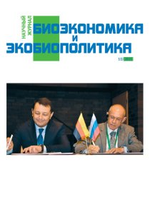Structure of Joint Industrial and Academic Cooperation in the Field of Bioeconomy in Germany
Автор: Kircher M.
Рубрика: Тезисы
Опубликовано в Биоэкономика и экобиополитика №1 (1) декабрь 2015 г.
Дата публикации: 15.01.2016
Статья просмотрена: 7 раз
Библиографическое описание:
Kircher, M. Structure of Joint Industrial and Academic Cooperation in the Field of Bioeconomy in Germany / M Kircher. — Текст : непосредственный // Биоэкономика и экобиополитика. — 2015. — № 1 (1). — URL: https://moluch.ru/th/7/archive/20/667/ (дата обращения: 25.04.2025).
In our understanding the Bio-Economy encompasses the production of materials, chemicals and energy.
It addresses all fields of our daily life: Food and feed (e.g. supplements), equipment (plastics), machinery (lubricants), consumer care (cosmetics, detergents), medicine (implants, drugs), mobility (fuel), energy (biogas) and more.
Academic Science
The transformation of the industrial feedstock base (which is predominantly biomass plus carbon sources from recyling) asks for new technologies in preprocessing raw materials, transformation into intermediates and finally producing consumer products. In providing the science basis for these technologies academic institutions play the key role in fundamental and applied research and - equally important - education of young scientists. The Technical Universities Aachen (RWTH) and Munich (TUM), to name just these two because they are joining this conference, are active in basic research on using sustainable feedstock and concerning education the University of Hohenheim implemented shortly its Bioeconomy Master Program.
Technology Transfer
Applying scientific results in industrial reality needs technology transfer. In Germany early cooperation of academic institutions and industry (SME and big industry) is one of the preferred models. All universities run offices for licensing technologies ready to be applied. Forming R&D partnerships with German and international institutions is another activity. In addition these offices offer support in raising public and private funds – not only for R&D projects but also for spinning out start-ups as a way of technology transfer. One of the latter examples is SeSam Biotech, a spin-off from Jacobs Bremen University.
Cluster
Another model of technology generation and technology transfer are clusters comprising all bioeconomy stakeholders. Because mostly industry-oriented clusters help to identify new business options not only for individual companies but whole sectors; thus supporting the realization of bioeconomy value chains. Examples for bioeconomy clusters in Germany are IBB Netzwerk (Munich) focusing on Bavaria, the Bioeconomy Cluster in Leuna centered on its pilot plant about chemicals from woody biomass and CLIB2021 (Duesseldorf) which is oriented to chemical industries. International Partnering
Bioeconomy value chains have a global dimension - both concerning raw materials and products. The focus of clusters goes therefore beyond Germany. Bavaria is part of a partnering program along the river Danube, the Leuna cluster just signed the 3BI initiative with Dutch, French and British organisations. CLIB2021 founded together with the leading chemical EU-regions in Flanders (Belgium) and The Netherlands the Bio-Innovation Growth Cluster BIG-C and works since many years in strategic partnerships with Brazil, Canada, Malaysia and last not least Russia. Especially Russia with its long tradition in bioprocessing science and industrial practice is seen as a most promising partner on the way into the bioeconomy.







